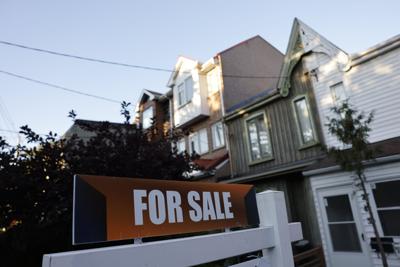Home affordability in Canada won’t see meaningful improvements any time soon, according to a new report.
Despite mortgage rates recently softening and home prices in some parts of the country falling, the affordability index remains “near historically low levels,” the latest Desjardins Affordability Index report has found.
Housing affordability hasn’t “meaningfully recovered” since the pandemic’s rapid price growth and subsequent interest rate increases, it added, though Desjardin economist and report author Kari Norman emphasized the problem has been decades in the making.
The average price of a home in Canada has quadrupled over the last 25 years, while the average household disposable income only just more than doubled, the report published Wednesday said.
While the affordability index isn’t expected to worsen in the near-term, many Canadian regions remain “deeply unaffordable,” the report said.
Interest rates will likely “continue their downward path” due to the impact of the U.S.-instigated trade war, but rising unemployment is also in the forecast and expected to have an impact on households’ disposable income.
Monthly home sales figures in the first quarter of 2025 “fell sharply,” the report found, as prospective homebuyers hesitated due to economic uncertainty.
The new-build sector, in particular, is expected to be “hammered by tariffs and retaliatory tariffs” over the next two years, it added.
But homes are not expected to become affordable in the next couple of years as prices are projected to rise in 2026, the report noted.
“As we’re coming out of the trade war, then home prices will start to pick up again, home sales will start to be bid on again, so affordability will deteriorate slightly next year in our predictions,” Norman said, adding Prime Minister Mark Carney and U.S. President Donald Trump will presumably reach a trade deal.
The widening gap between home prices and incomes also means prospective homebuyers take longer to save for their down payment, said the report, which used data from the Canadian Real Estate Association, Statistics Canada and Desjardins Economic Studies.
If households with average earnings save 20 per cent of their disposable income in an account with three per cent interest, it would take them about six years to accumulate the money to buy an average home in Canada, the report said.
But the timeline is longer for those in Ontario and B.C., where home prices are higher — about seven and seven and 7.5 years, respectively, Norman said.
Additionally, the report said “high rent inflation” from 2022 to 2024 likely made it more difficult for would-be homebuyers to save up a nest egg.
In fact, one in three renters are likely to miss a debt payment, the report found, as they’ve increasingly struggled with their personal finances.
While the federal government has introduced policies to help households get their foot in the door of home ownership — such as the First Home Savings Account and the December 2024 increase on the price cap for insured mortgages — Norman said they could be creating more demand, which could then lead to higher prices.Â
“When you make it cheaper to buy, you get more people who can afford to buy, but it takes a long time to build homes,” she explained, adding the average timeline for a multi-family home is about seven years.
“So we can increase demand overnight by these policies, but it takes years to bring on that supply, so we really need to to work on building that supply so that we’re not only increasing demand,” she said.































To join the conversation set a first and last name in your user profile.
Sign in or register for free to join the Conversation